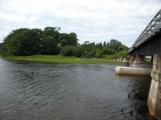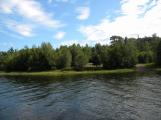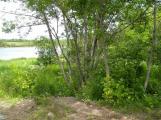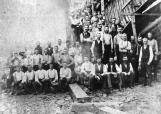27
Meanwhile, from 1800-1820, the lumber trade was developing. The Napoleonic Wars and their aftermath severed the timber supply from the Baltic and Great Britain needed timber. Ships were wanted to transport the timber, and with such ready markets, this greatly encouraged the shipbuilding industry in Nova Scotia.Before 1830, the first vessels were inexpensively and hurriedly built for the English market. They did not have a good reputation abroad! Sold outright, the builders did not receive a share for their work. This phase of the shipping business ceased after the war.
28
Alexander Campbell, Tatamagouche, Nova Scotia, CanadaLate 1800's
Tatamagouche, Nova Scotia, Canada
 Credits:
Credits:North Shore Archives CSHC
Roy Kennedy
Frank Patterson
29
The first registered ship in Tatamagouche was the schooner "Fish Hawk", launched on May 1, 1818 and weighing in at 16 tons. Many settlers built vessels for their own personal use. For example, Fred Hayman and his schooner "Nancy" caused a stir in 1823, for at 73 tons she was the largest ship built in the area. Other small scale builders included Isaac Langille of Brule Point (1826), Ephraim Mattatall (1829), and William Fraser (1840) who later became Alexander Campbell's master builder.In 1825, the people of Tatamagouche had little contact with the rest of the world. By 1847, however, Tatamagouche ships sailed to every corner of the globe. This extraordinary change was mainly brought about by Alexander Campbell, known as the founder of Tatamagouche's shipbuilding industry.
Campbell began looking after the cutting, loading, and shipping of pine, staves, and boards sawn in the water powered sawmills earlier established by Colonal DesBarres, Wellwood Waugh, and other settlers. He noticed that traders needed larger schooners, and with William Mortimer, began to build them. There was no shortage of help, for times in the new colony were tough, and workers were willing to provide their services for "corn meal and molasses".
The huge acreages of land and the sawmills he took over and built, enabled Campbell to expand his business.
30
Alexander Campbell Wharf and Warehouse, Tatamagouche, Nova Scotia, Canada3 July 2010
Tatamagouche, Nova Scotia, Canada
 Credits:
Credits:S. Brinkhurst
Harris LeFresne
31
Alexander Campbell's first schooner was the "Elizabeth" of 91 tons, launched May 17th, 1824. He established his shipyard on the west bank of the French River and began to build for sales in the "Old Country" (England) with the brig "Devron" of 281 tons. She was the first of the ocean going ships built in Tatamagouche, and sold to England, but nothing else is known about her.In 1830, Campbell left the firm of Mortimer and Smith and bought land from the DesBarres estate for a home. He built his house, known as "Rose Cottage", almost overlooking the section of shore which was to become his shipbuilding enterprise. The Campbell brothers, Alexander, James, and William worked together until a bitter quarrel between James and Alexander split them apart in 1833. James built a shipyard elsewhere along the shore.
William Campbell also built a shipyard on the opposite bank from his brother, Alexander. He operated from 1833 to 1842. He found success in this trade, building eleven vessels and constructing a sawmill on the French River. His business ended with the shipwreck of "Trident", a barque of 354 tons at Placentia Bay, Newfoundland. This ruined him financially and he did not have the means to continue his trade. He became a farmer.
In 1843 there was a relaxation in the dispute between Alexander and James, and they built the barque "Heroine". Alexander is the best known brother and the one who took on shipbuilding as his life's work.
32
William Campbell Shipyard, Tatamagouche, Nova Scotia, Canada3 July 2010
Tatamagouche, Nova Scotia, Canada
 Credits:
Credits:S Brinkhurst
33
William Campbell went on to establish his own shipyard, across the river from Alexander. He built large ships that he sold to the shipping firm of Miller Cannon and Co. of Liverpool, England. The unsold ships would return to Tatamagouche to either be used or sold here, or would be sent across the Atlantic again at a later date for a second attempt at selling. His barque "Colchester", built in 1835, was a huge success, being the largest and most advanced ship in the county at that time. He continued to build for about ten years.34
Shipyard Site Near Creamery Square Heritage Centre, Tatamagouche, Nova Scotia, Canada3 July 2010
Tatamagouche, Nova Scotia, Canada
 Credits:
Credits:S. Brinkhurst
35
Through the 1830s, the trend was away from smaller vessels and towards larger ships, such as barques, brigantines, and brigs for the English market. Alexander Campbell supplied ships to meet the market demand. He built most of these ships at his yard, but some were built in other locations, including the Mockler Shipyard in Brule and at Wallace Bay.Campbell has since become known locally as the 'Father of Shipbuilding'. Frank Patterson, in 1917, refers to him as "honest in his dealings, sound in his judgement, endowed with great natural ability, and possessing a commanding personality".
36
"Ashantee" of Tatamagouche, Nova Scotia, Canada1874
North Shore, Nova Scotia, Canada
 Credits:
Credits:North Shore Archives CSHC
37
Although there was a serious financial depression in 1840's, destroying shipbuilding in many similar sized coastal regions, Tatamagouche recovered. For example, Alexander Campbell built the following number of ships during the next few years: 1843: 5 ships; 1845: 5 ships; 1846: 5 ships; 1847: 6 ships; 1848: 3 ships 1849: 5 ships and 1850: 7 ships. He did extremely well in his trade, owning a variety of businesses associated with the shipbuilding, and he appeared to live well.On Alexander Campbell's property there was a blacksmiths shop, providing iron for the ships; a shipyard, wharf and warehouses extended almost to the mouth of the river; the wharf handled cargos and rigging for ships. A sawmill was added near the mouth of the river; the equipment coming from "Brantford Engine Works, makers of steam engines". It was said that if he did not own the first steam-powered mill in North Colchester, then certainly the second. He added a steam-powered gristmill next to the sawmill.
Rope and canvas came in from Halifax and John Irvine worked as a blockmaker in the shipyard.
38
Half model of the "Jumna", Tatamagouche, Nova Scotia, CanadaLate 1800's
Tatamagouche, Nova Scotia, Canada
 Credits:
Credits:Sunrise Trail Museum, CSHC, Tatamagouche, Nova Scotia, Canada
39
From 1840-1850, houses were constructed on an area to the west of the French River for people working for Campbell in the shipbuilding industry. Called "Mechanic Street", it might have turned into the site of the village, but in fact the village developed on the east side of the river where later there were a number of stores, including tinsmiths, general and hardware stores, and blacksmiths.The Campbell ships ranged from a 24 ton schooner "Sarah" in 1836 to a 900 ton barque "Minnie Carmichael" in 1877. The latter was so big that when being built, her bowsprit extended over the main roadway leading to the highway bridge.
Alexander Campbell died in 1854 after returning from a sitting of the Legislative Council in Halifax to which he was elected in 1838. At one time he held 75 parcels of land totalling 8694 acres (3478 hectares) and the family appeared to live well, suggesting a degree of wealth. On his death, however, there seems to have been very little for his wife to live on.
40
"Yolande" Construction Crew, Tatamagouche, Nova Scotia, Canada1883
Tatamagouche, Nova Scotia, Canada
 Credits:
Credits:North Shore Archives CSHC